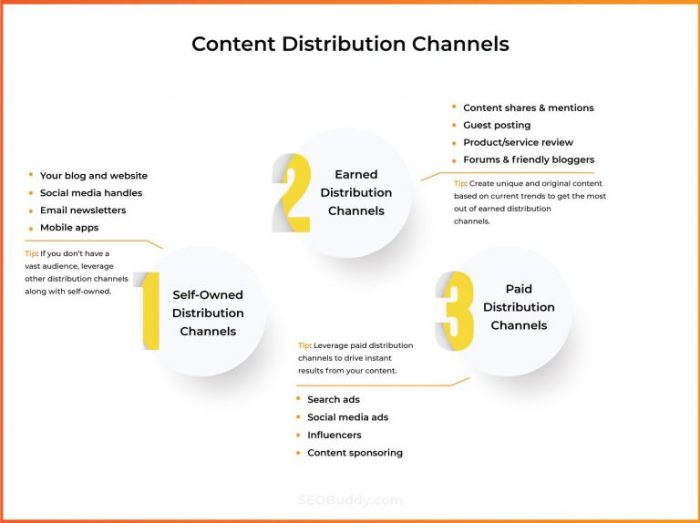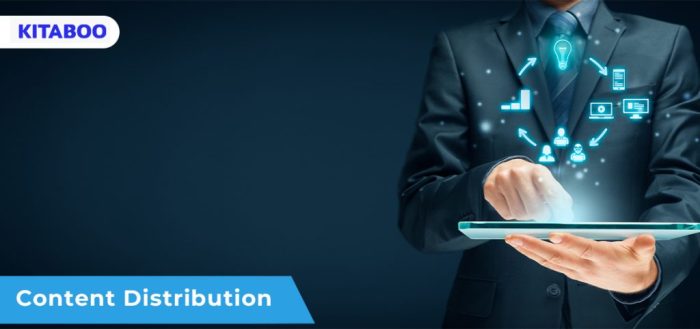Understanding Content Distribution is key to amplifying your message and connecting with your audience on a deeper level. From social media to email marketing, explore the diverse channels that can elevate your content to new heights.
Unveil the secrets behind effective distribution strategies and learn how to craft a tailored approach that resonates with your target demographic.
Introduction to Content Distribution
Content distribution refers to the process of sharing and delivering content to a target audience through various channels. It involves getting your content in front of the right people at the right time to maximize its impact and reach. Effective content distribution is crucial for ensuring that your message is seen and engaged with by your intended audience.
Different Content Distribution Channels
- Social Media Platforms: Platforms like Facebook, Instagram, Twitter, and LinkedIn allow for easy sharing and distribution of content to a wide audience.
- Email Marketing: Sending out newsletters and promotional emails to subscribers is a great way to distribute content directly to interested individuals.
- Content Syndication: Partnering with other websites or platforms to republish your content can help expand your reach and increase visibility.
- Search Engine Optimization (): Optimizing your content for search engines can help improve its visibility and ranking in search results.
Importance of Effective Content Distribution Strategies
Effective content distribution strategies are essential for maximizing the impact of your content and reaching your target audience. By utilizing the right channels and tactics, you can increase brand awareness, drive traffic to your website, generate leads, and ultimately increase conversions. Without a solid distribution plan, even the best content may go unnoticed, so it’s crucial to invest time and resources into developing a comprehensive strategy.
Types of Content Distribution Channels

When it comes to distributing your content, there are various channels you can explore to reach your target audience. Each channel has its own unique advantages and effectiveness in reaching different segments of your audience. Let’s dive into some of the most common types of content distribution channels and how they compare in terms of effectiveness.
Social Media
Social media platforms like Facebook, Instagram, Twitter, and LinkedIn are popular channels for distributing content. They allow you to reach a wide audience quickly and engage with your followers through likes, shares, and comments. Social media is great for building brand awareness and driving traffic to your website.
Email Marketing
Email marketing is another effective content distribution channel that allows you to deliver personalized content directly to your audience’s inbox. By segmenting your email list and sending targeted campaigns, you can nurture leads and drive conversions. Email marketing is known for its high ROI and ability to build long-term relationships with your audience.
Influencer Partnerships, Understanding Content Distribution
Collaborating with influencers in your industry can give your content a significant boost in visibility. Influencers have a loyal following that trusts their recommendations, making them powerful advocates for your brand. By partnering with influencers, you can tap into their audience and reach new potential customers.
Selecting the Right Distribution Channels
When choosing the right distribution channels for your content, consider the type of content you are creating and your target audience. For example, if you are targeting a younger demographic, platforms like TikTok and Snapchat might be more effective than LinkedIn. It’s important to research your audience’s preferences and behavior to determine which channels will yield the best results for your content distribution strategy.
Benefits of Understanding Content Distribution
Understanding how content distribution works can have numerous benefits for individuals and businesses alike.
Increased Reach and Visibility
- By strategically distributing content across various channels, you can reach a wider audience and increase visibility for your brand.
- Example: A clothing brand partners with popular fashion influencers on social media to showcase their products to a larger audience, resulting in increased brand visibility and reach.
Enhanced Engagement and Interaction
- Understanding content distribution allows you to tailor your content to specific platforms and audience preferences, resulting in higher engagement levels.
- Example: A food delivery service creates interactive and engaging videos on TikTok showcasing their easy ordering process, leading to increased user interaction and brand engagement.
Improved Brand Authority and Credibility
- Effective content distribution can position your brand as an authority in your industry, building trust and credibility with your target audience.
- Example: A financial institution consistently shares informative and educational blog posts on personal finance topics, establishing themselves as a reliable source of information and expertise.
Metrics and Analytics in Content Distribution

Tracking metrics in content distribution is crucial for evaluating the effectiveness of your strategies. By analyzing data and key performance indicators (KPIs), you can make informed decisions to optimize future content distribution efforts.
Key Performance Indicators (KPIs)
- Reach: Measure the number of unique viewers who have seen your content to gauge its visibility.
- Engagement: Evaluate the level of interaction such as likes, shares, comments, and click-through rates to assess audience interest.
- Conversion Rate: Monitor the percentage of viewers who take a desired action after engaging with your content, such as making a purchase or signing up for a newsletter.
- Retention: Track how many users continue to engage with your content over time to measure loyalty and satisfaction.
Analytics Tools for Optimization
Utilizing analytics tools like Google Analytics, SEMrush, or HubSpot can provide valuable insights into user behavior, content performance, and trends. These tools offer detailed reports on website traffic, audience demographics, and conversion rates, allowing you to refine your content distribution strategies for better results.












